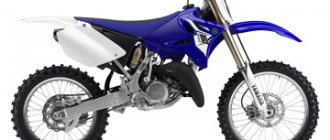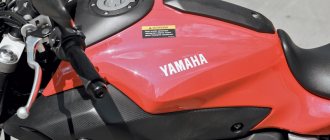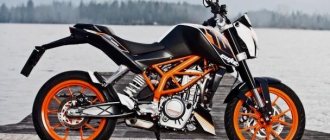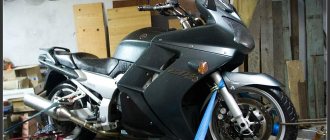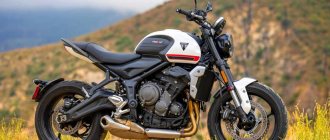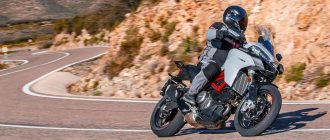| Yamaha YZ250F (2001-2005) | Yamaha YZ250F (2006) | Yamaha YZ250F (2007-2009) |
| Yamaha YZ250F (2010-2013) | Yamaha YZ250F (2014-2018) | Yamaha YZ250F (2019-2020) |
| Yamaha YZ250F (2021) | Yamaha YZ250F (2022+) | Yamaha YZ250F Monster Energy Yamaha Racing Edition (2022) |
Yamaha YZ250F motocross model
appeared in 2001 as a 4-stroke motocross model designed to replace the 2-stroke Yamaha YZ250. It should be noted that this step was taken by the entire Japanese “quartet” of motorcycle manufacturers, the only difference being that 2-stroke motocross motorcycles from Yamaha were so successful that they continue to be produced in parallel with 4-stroke ones and even compete in the same racing class.
The Yamaha YZ250F was based on a 1-cylinder 4-stroke liquid-cooled engine with a volume of 249 cm³, with 5 valves, producing about 42 hp. power and 29 Nm of torque.
In 2006, the model underwent a major update, the main innovation of which was the transition from a steel to an aluminum frame. It was from this moment that the YZ250F model became a full-fledged player in the market of motocross models with an engine capacity of up to 250 cm³.
For 2008, the model receives a new engine that has been further optimized, slightly increasing maximum power and torque characteristics.
For 2010, the Yamaha YZ250F gets a new fork and repositions the engine in the frame to lower the center of gravity and improve handling. Overall optimization allowed us to achieve a record curb weight of 102 kg.
2014 marked the new generation of the Yamaha YZ250F. The motorcycle received a new front fork, a new engine with an injection power system and an increased compression ratio (from 12.5 to 13.5), a 4-valve cylinder head (instead of 5-valve). In 2021, the model received a new front brake disc (diameter increased from 250 to 270 mm).
In 2021, Yamaha again updates the YZ250F, which, in addition to changes in appearance, receives a new engine (compression ratio increases from 13.5 to 13.8), a new rear shock absorber (changed settings) and an electric start.
For 2021, Yamaha has introduced a new generation of the YZ250F. The updated model received a new cylinder head, control unit, intake system, modified frame, new suspension settings and an updated brake system (updated calipers, discs, brake pads, rear disc diameter reduced from 245 to 240 mm).
Yamaha is releasing an updated YZ250F at the end of 2021. The new model received a wider rear wheel (100 → 110 mm), updated graphics and optimized suspension settings.
The Yamaha WR250 enduro series and the Yamaha YZ250FX hard enduro series (available since 2015) were built on the basis of the Yamaha YZ250F.
The main competitors of the Yamaha YZ250F in the class:
- Honda CRF250R
- Kawasaki KX250F
- Suzuki RM-Z250
Bike features
Here are the main features of the model:
- rarity while maintaining relevance;
- exclusivity in its niche;
- convenience and balance.
The Yamaha UZ 250 can be called a legend, because such motorcycles are rare. Probably, the model is primarily suitable for those people who prefer to purchase equipment that has been proven over the years. After all, this model will soon be tested by half a century.
Yamaha yz250f engine
Yamaha yz250f
One of the important points of last year's update to the Yamaha yz250f was the engine. The developers have changed the design of more than 15 components, increasing traction at medium and high speeds and increasing maximum power. It must be said that other manufacturers also followed this path in their desire to catch up and surpass the leader in this segment, the KTM 250 SX-F.
Yamaha did quite well: the 2021 YZ250F produces 0.8 hp more at peak - real 39 hp from the wheel at 13,000 rpm on the dyno (real measurement here). On the track, the increase is also noticeable, and in the most pleasant way: the YZ pulls longer at the top and requires fewer shifts. In the 2022 version, the engine remains unchanged, and additionally its character allows for tuning with the free Power Tuner app. For example, those who still find the current version of the engine not powerful enough can be helped by a special “over-Rev Map” that comes with the application and allows you to turn the engine in each gear a little longer, which is especially useful on fast tracks .
In fact, the characteristics of the Yamaha YZ250F cannot be called low-end: in 2014, the engine was actually updated so that the main thrust was shifted to lower and middle speeds, but the 2021 version has become more leveled in this regard. Another thing is that the low end remains very high-torque, and the engine turns very easily, so it may seem that the torque plateau is a little short, especially for those who are accustomed to 450 motocross models or simply open the gas immediately to full - then yes, reach the cutoff can be done very quickly. There is only one solution: shift more often - the engine easily pulls out at low speeds even in higher gears.
Yamaha, Honda and Suzuki equip their 250cc four-stroke motocross models with a cable clutch, while Kawasaki and the Austrians have switched to hydraulics. The Yamaha's lever action is smooth, confident and predictable, and is generally quite stable, although the clutch does float a bit under heavy loads. Fortunately, thanks to the beefy bottom end, there's no need to drag the clutch too often or for too long on the YZ250F.
The only real disadvantage of the Yamaha YZ250F engine is its starting, in particular its periodic reluctance to start. Sometimes it takes two or three presses of the starter button to fire it up - not a big deal when you're at the starting line, but a pretty nasty bottleneck somewhere in a hot race that can cause you to lose a position or two if you accidentally stall.
Yamaha yz250f
Dimensions and weight
The weight of the model is only 103 kg, including fuel. However, there is nothing special in this indicator, because low weight is generally typical for cross-country motorcycles. The tank volume here is 8 liters, which is partly responsible for the low weight of such equipment. The seat height is 976 mm and the wheelbase is 1446 mm.
Driving performance
The driving performance of this cross-country monster is still relevant today, although it has been gone for almost twenty years since the model was introduced.
Per 100 km, the Yamaha YZ 250 F consumes from 5.5 to 6 liters of fuel . The difference depends on the wear of the chassis and the quality of gasoline.
Fuel consumption
In an effort to improve the model, the developers first increased the tank to 7.5 liters, which allowed it to travel more than 100 km, then reduced it to a minimum.
Users note that the volume to the neck is just over 6 liters .
Speed
The maximum speed of the model is only 165 km/h. Here I would like to dwell in more detail, most of the data speaks about exactly this parameter, but our friends were able to squeeze out of it no more than 130 km/h at stock settings.
But good suspension, increased fork travel, as well as the minimum weight of the model enable the motorcyclist to overcome the most difficult sections and (if desired) fly part of the way in a jump, which allows increasing performance.
A lightweight and nimble bike that is equally stable on the ground or when performing tricks, adding to the confidence of the rider.
Chassis and brakes
Initially, the frame of the YZ 250 was made of steel, but since 2005 the model finally received an aluminum frame, which had a positive effect on its driving performance. The exterior looks great, and if you look at this beautiful motorcycle without knowing its history, you might think that it is some kind of new product.
A progressive monoshock serves as the YZ 250's rear suspension, while an inverted fork is used here as the front suspension. The rear brake is a 245 mm disc with a single-piston caliper, and the front brake is a 250 mm disc supported by a two-piston caliper.
Brief history of the model
- 2001 - Model
: Yamaha YZ250F (All markets).
Factory designation
: 5NL1, 5NL2, 5NL3, 5NL4.
- 2002 - Model
: Yamaha YZ250F (All markets).
Factory designation
: 5SG1, 5SG2, 5SG3, 5SG4.
- 2003 - Model
: Yamaha YZ250F (All markets).
Factory designation
: 5UL1, 5UL2, 5UL3, 5UL4.
- 2004 - Model
: Yamaha YZ250F (All markets).
Factory designation
: 5XC1, 5XC2, 5XC3, 5XC4.
- 2005 - Model
: Yamaha YZ250F (All markets).
Factory designation
: 5XC5, 5XC6, 5XC7, 5XC8.
- 2006 - Model
: Yamaha YZ250F (All markets).
Factory designation
: 5XC9, 5XCA, 5XCB, 5XCC, 5XCD, 5XCE, 5XCF.
- 2007 - Model
: Yamaha YZ250F (All markets).
Factory designation
: 5XCG, 5XCH, 5XCJ, 5XCK.
- 2008 - Model
: Yamaha YZ250F (All markets).
Factory designation
: 5XCL, 5XCM, 5XCN, 5XCP.
- 2009 - Model
: Yamaha YZ250F (All markets).
Factory designation
: 5XCR, 5XCS, 5XCT, 5XCU.
- 2010 - Model
: Yamaha YZ250F (All markets).
Factory designation
: 17D5, 17D6, 17D7.
- 2011 - Model
: Yamaha YZ250F (All markets).
Factory designation
: 17DD, 17DE, 17DF.
- 2012 - Model
: Yamaha YZ250F (All markets).
Factory designation
: 17D9, 17DA, 17DB.
- 2013 - Model
: Yamaha YZ250F (All markets).
Factory designation
: 17DH, 17DJ, 17DK.
- 2014 - Model
: Yamaha YZ250F (All markets).
Factory designation
: 1SM1, 1SM2, 1SM3.
- 2015 - Model
: Yamaha YZ250F (All markets).
Factory designation
: 1SM5, 1SM6, 1SM7.
- 2016 - Model
: Yamaha YZ250F (All markets).
Factory designation
: 1SM9, 1SMA, 1SMB, 1SMD, 1SMF, 1SMG.
- 2017 - Model
: Yamaha YZ250F (All markets).
Factory designation
: 1SME, 1SMJ, 1SMK.
- 2018 - Model
: Yamaha YZ250F (All markets).
Factory designation
: 1SMM, 1SMN, 1SMP.
- 2019 - Model
: Yamaha YZ250F (All markets).
Factory designation
: YZ250FKL, YZ250FKW.
- 2020 - Model
: Yamaha YZ250F (All Markets).
- 2021 - Model
: Yamaha YZ250F (All Markets).
- 2022 - Model
: Yamaha YZ250F (All Markets).
Power
How fast is she?
Yamaha and KTM have long been firmly stuck in the struggle between “old and new.” The 2021 KTM 250SX is a lot more powerful than the YZ250, but that doesn't mean it's faster. On the dyno, the KTM produces 47.2 hp and the YZ250 46.08, but keep in mind that the Yamaha YZ250 peaks at 8,800 rpm, while the 250SX peaks at 8,200. The difference at peak is about 1 horsepower. force, and this is very little in real conditions, but the nature of the thrust distribution of these engines is very different.
On the move, the KTM 250SX has significantly more torque from low to mid-range, and is up 4 hp. more powerful than the Yamaha YZ250 at 7000 rpm. He shoots powerfully, pulls powerfully and runs out of steam early. Four horses at mid-range is a lot, but it runs out of steam at 8200, and the Yamaha at peak 8800 is 4.7 horsepower more powerful than the KTM. The KTM 250SX is great from the bottom up and the Yamaha YZ250 is awesome up top. It's interesting how different it feels to ride a crowbar at the bottom versus a classic motocross power top. The Yamaha YZ250 engine feels more manageable and comfortable than the more powerful KTM 250SX.
Controllability
How does the 2021 Yamaha YZ250 handle?
In short, if you liked the 2021 version, you'll like this one. And in short: there's nothing much to say about its handling, because it just does everything right. Its straight-line stability is not sacrificed for turning, it is nimble without sacrificing accuracy, and rigid without sacrificing tractability. In three words: predictable, stable workhorse (okay, let's say in four). Perhaps this did not sound like ecstatic praise, but this is precisely because there is no reason for ecstasy here. The 2021 Yamaha YZ250 isn't the best handling, but it's good enough to win races.
Yamaha yz250f chassis and handling
Last year's chassis update had a pretty significant impact on the handling of the Yamaha YZ250F, and improvements for the 2022 model year have improved it even further. The bike handles sharper but retains incredible stability, which is especially noticeable on fast, rough trails. The YZ250F doesn't feel like it dives into corners quite as sharply as the Honda CRF250R or Suzuki RM-Z250, which turn in a breeze, but the Yamaha still steers well, requiring a small but conscious effort to lean into a turn, which it takes with confidence and precision.
Regarding the ergonomics of the Yamaha YZ250F, the first thing you notice is the position of the handlebars. In the upper yoke there are not two, but four holes for installing spacers, a pair of near ones and a pair of distant ones, and the spacers themselves can be installed turning forward or backward, and thus, four options for the steering wheel position are available. The stock handlebars are set to third, with the spacers in the front holes facing back, and Yamaha says they chose this position because it transfers more weight to the front wheel, which improves traction in corners.
For short people, a closer steering wheel position is more suitable, otherwise you will have to reach for it at times. It’s best to clarify this question for yourself in advance, on quiet rides, try all the options and choose the best one. Either way, having a choice is great.
Is it worth buying
Is it worth buying?
In general, motocross motorcycles are rapidly becoming obsolete consumables with a short service life. They are inherently designed to be replaced at any time by a newer model.
But not the Yamaha YZ250 two-stroke. Because this model was just as good 13 years ago, and now, in the 2021 model year, it is still good and is not much different. Moreover, there are now more motorcycles of this model on the road and in active use than any other classmates. Ask what 2006 motocross bike is currently on the track, and the Yamaha YZ250 and YZ125 immediately come to mind. It is quite possible to invest in it, because when the time comes to sell it, there will be a line of people willing to buy it.
Cons of the Yamaha YZ250
- Chassis. The chassis of this model has always been average - and remains so. Literally. It understeers and wobbles under load. But if Yamaha can improve the 2021 YZ450F with beefier forks, think what can be achieved with the YZ250
- Engine. Not a bad traction characteristic, but its Austrian classmate leaves the YZ250 to bite the dust, even at the start, even on a slope, even in the sand. Yes, you can resort to tuning, but we are now talking about a new and stock model, and not about what else you can buy for the same money.
- The Dunlop MX52 front wheel makes the front end look worse than it already is. You'll need to budget for better tires right away to get the most out of the YZ250's aluminum frame. But from behind, the MX52 performs quite well, especially in the mud.
- Transfers. Switching from second to third does not work the first time. Fortunately, third can be ridden throughout the rev range, but the ideal would be to move third closer to second (like the enduro YZ250X), and until Yamaha makes a cross-box, we recommend setting the rear sprocket a tooth larger.
- Clutch. It's a little tight. It would be better if softer springs were installed in stock, and with a stiffer aftermarket it was possible to precisely regulate the stiffness of the lever.
2021 Yamaha YZ250FX On the Go
Thanks to the use of an updated version of the engine from the YZ250F, including a new piston, increased compression ratio, updated timing and valve timing, the traction character of the Yamaha YZ250FX has significantly improved compared to the previous (pre-2021) version. The pull is extremely smooth and controllable, but with powerful low end and improved high end. The elastic engine suits the FX extremely well due to the wide box, which has an extremely low first gear and high fifth and sixth gears, like on a drag bike. So, excellent acceleration from the bottom and effective high revs allow the YZ250FX to pull in any situation, even when riding tightly at the bottom, even when revved up to the point of ringing. The only caveat is that don’t forget to download Power Tuner and replace the stunted card with an aggressive one.
The gearbox, surprisingly, is quite sane on the cross-country track, but on the off-road route there were some nuances. On the cross-country, there are enough from the second to the fourth, which are not far from the cross-country box as a whole, and in an open-country race you don’t really go below fourth, but at the same time they are quite widely spaced, and there is a feeling that somewhere between them there is another one missing transfers. However, this is where the aggressive card came in handy.
Kayaba suspensions, for all their perfection, are still extremely softly tuned. This is easy to appreciate in rocky or root-strewn areas where they will swallow literally anything, but in fast open areas their softness becomes a disadvantage. For open country racing, it makes sense to put YZ250F springs in the fork, tighten the adjusters and raise the oil level.
All these features clearly make the Yamaha YZ250FX a great off-road bike, but not a great motocross bike. It is too soft, too slow, too heavy and clumsy for serious cross-country. It can be modified to decent motocross condition by replacing the suspensions, updating the ECU maps, adding an aftermarket muffler and selecting the most suitable sprockets (probably increasing the rear sprocket to improve performance in second to fourth gears).
Still, it's a great bike and a lot of fun to ride. Moreover, it is reliable enough to travel to uninhabited places - desert, mountains, forests.
Yamaha YZ250FX
Verdict
Yamaha diligently monitors forum opinions and dealer feedback and does its homework carefully based on these opinions. The Yamaha YZ250F motorcycle as a whole is close to ideal, and the only thing worthy of the developers’ attention is its ergonomics. Some issues can be corrected with fairly budget components from the GYTR catalog or an aftermarket, for example, putting the seat higher so that it is not only more comfortable to sit, but also easier to transfer weight, then a lower steering wheel, adjustable levers, other grips. But this is more a matter of taste than real problems:
Yamaha continues to produce an extremely organic and balanced cross-country 250 cc four-stroke, setting an excellent bar for fellow competitors, and providing cross-country riders with an excellent tool, suitable for both study and serious racing.
Yamaha yz250f suspension
The phenomenal suspension of the Yamaha yz250f cannot be attributed to the KYB SSS fork and KYB monoshock alone. Yes, these units have been considered the best stock suspension components for many years, but don’t discount the work that Yamaha does on them. Yes, they could have simply left everything as it is - and rightfully remained at the top in terms of suspensions for a few more years, but instead, the company's suspension team once again introduced a number of improvements that further improved the performance of the fork and shock absorber in accordance with the performance of the latest chassis generation debuting on the 2021 Yamaha YZ450F and the YZ250F a year later.
It is not so easy to find a balance of softness and efficiency in suspensions, which allows you to smooth out large irregularities without swinging and confidently hold the track. Yamaha has not only managed to find this balance, but has continued to maintain it for many years. On hard landings - for example, during a flight - KYB components show excellent resistance to breakdowns, while in other situations they provide a soft, comfortable ride. The suspensions require very little adjustment, if any at all, and every click of the adjuster makes a noticeable difference in their character. Many riders will only need to set the sag (sag), but those who are closer to the beginner than the pro may need to loosen the compression smoothing a little so that the suspension handles small bumps more gently, and then loosen the rebound smoothing. Yes, soft settings load the suspension on uneven areas, but they still do not sag too deeply and track the ground perfectly, while avoiding breakdowns on large uneven surfaces.
Weight
How much does the 2021 Yamaha YZ250 weigh?
It weighs 103kg (curb weight). And it's a lot lighter than the 108kg Yamaha YZ450F, but that's quite a lot for a 250cc two-stroke. Why? Because the KTM 250SX weighs 96 kg (and the 2021 model generally weighs 95.5 kg!!!).
